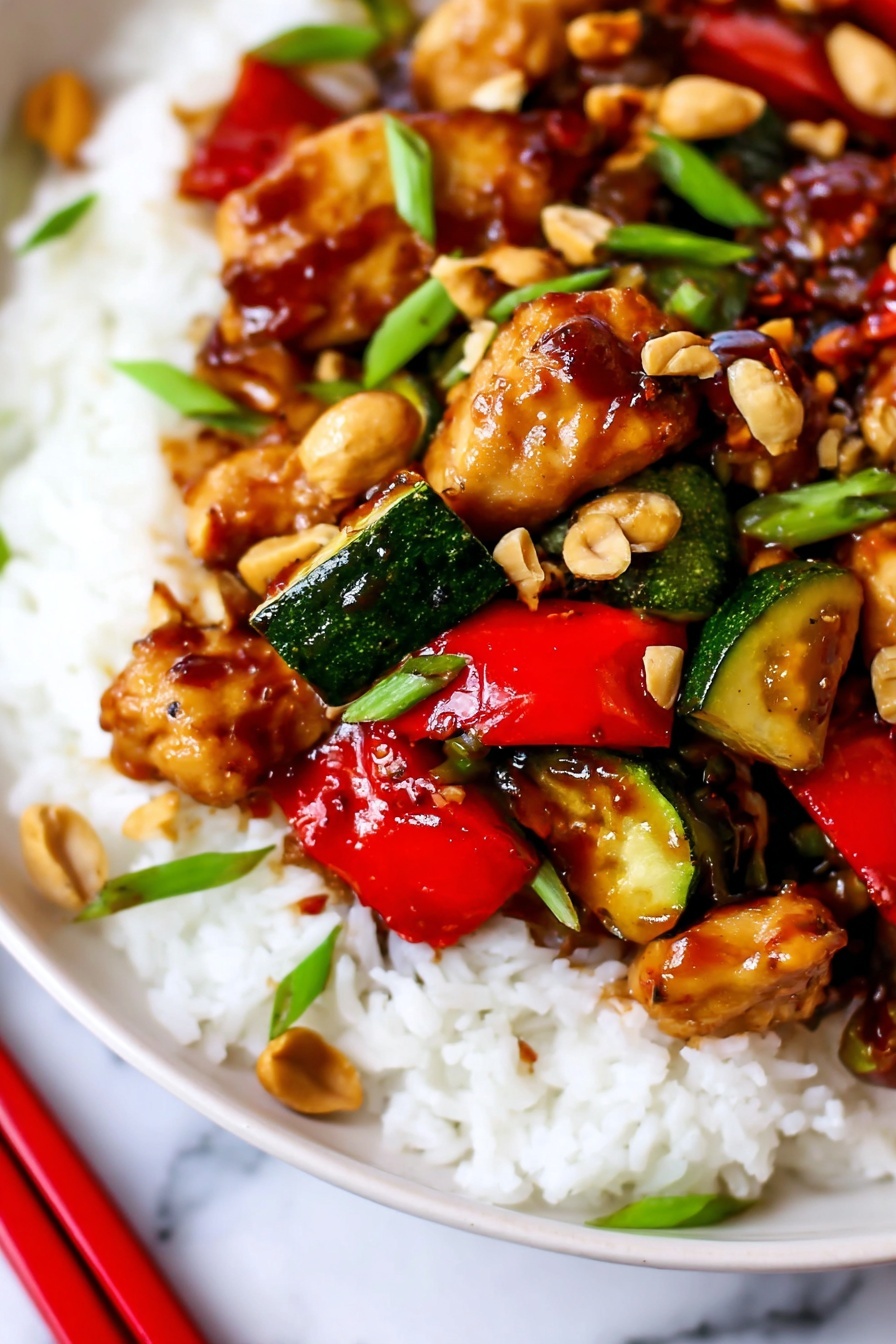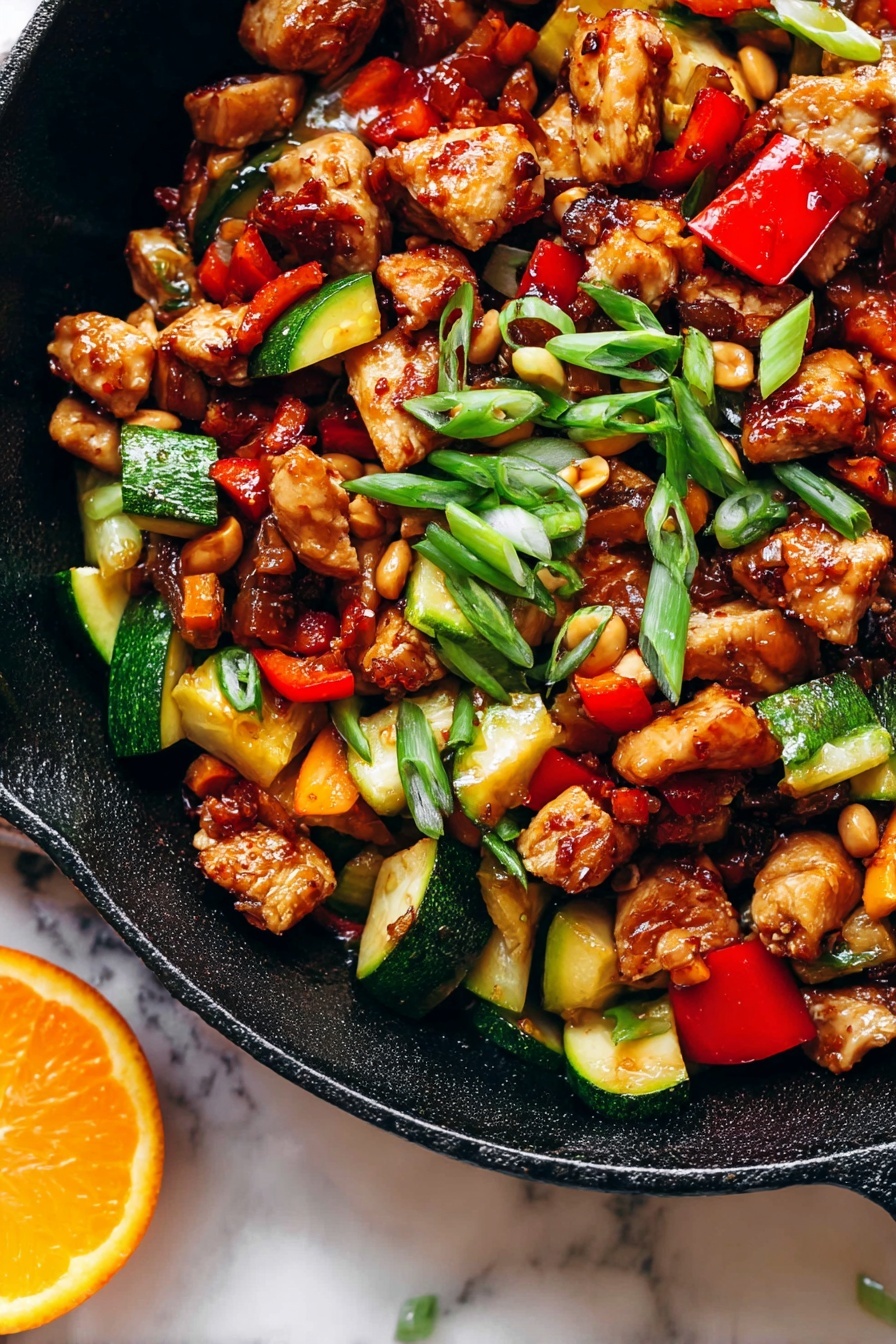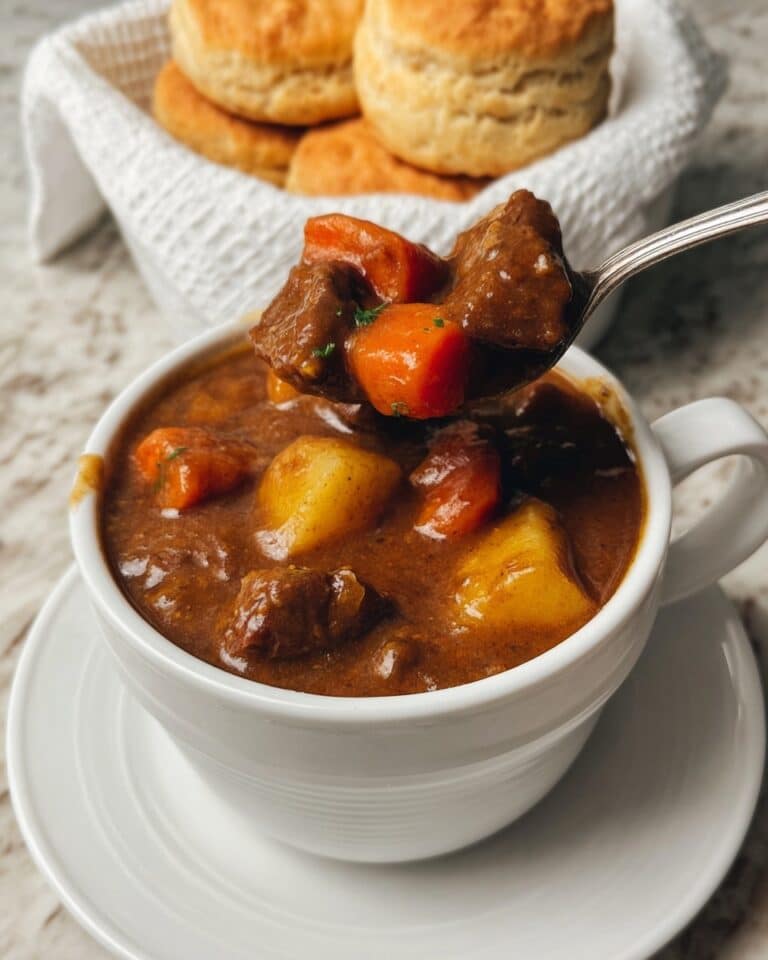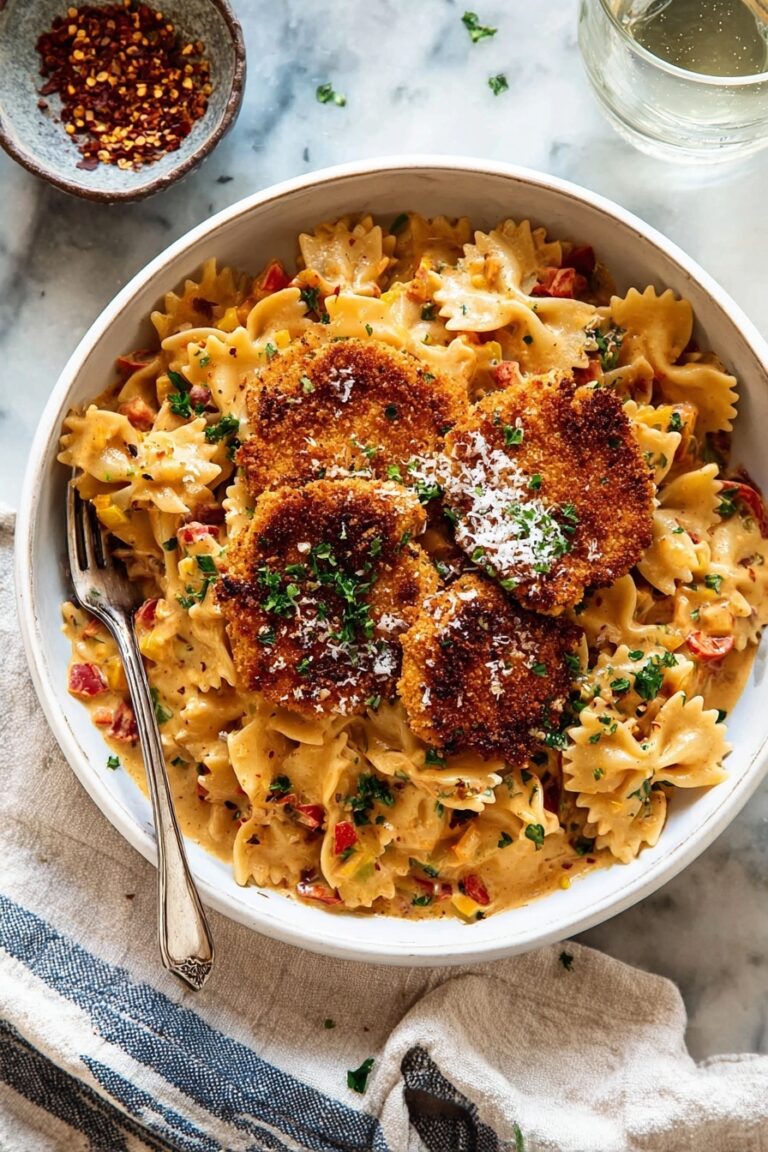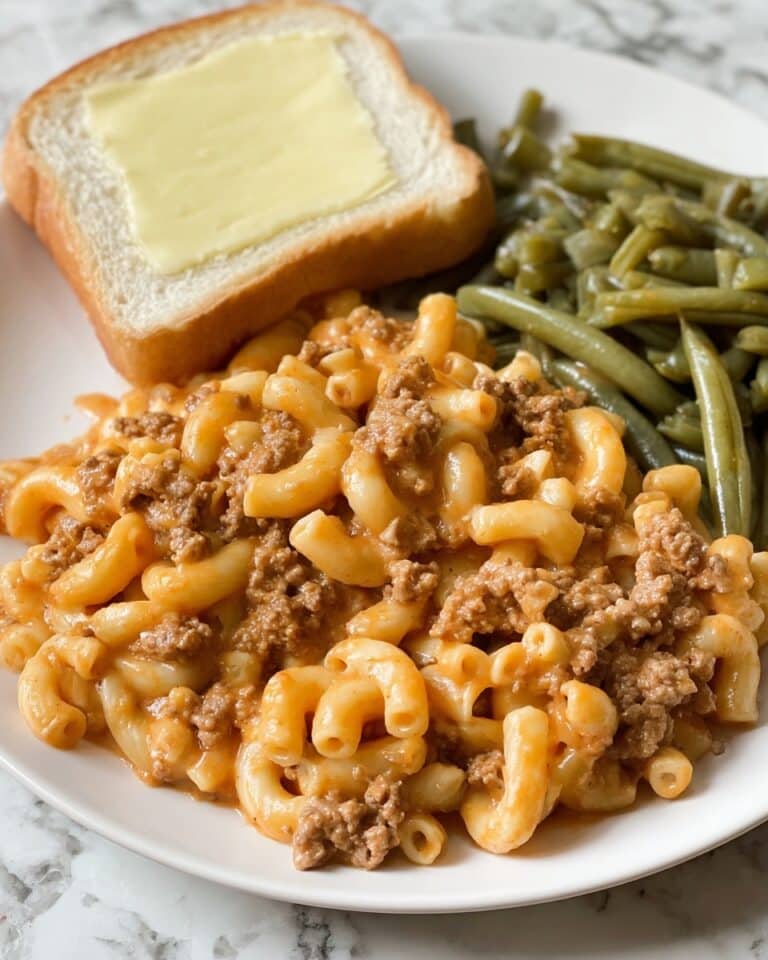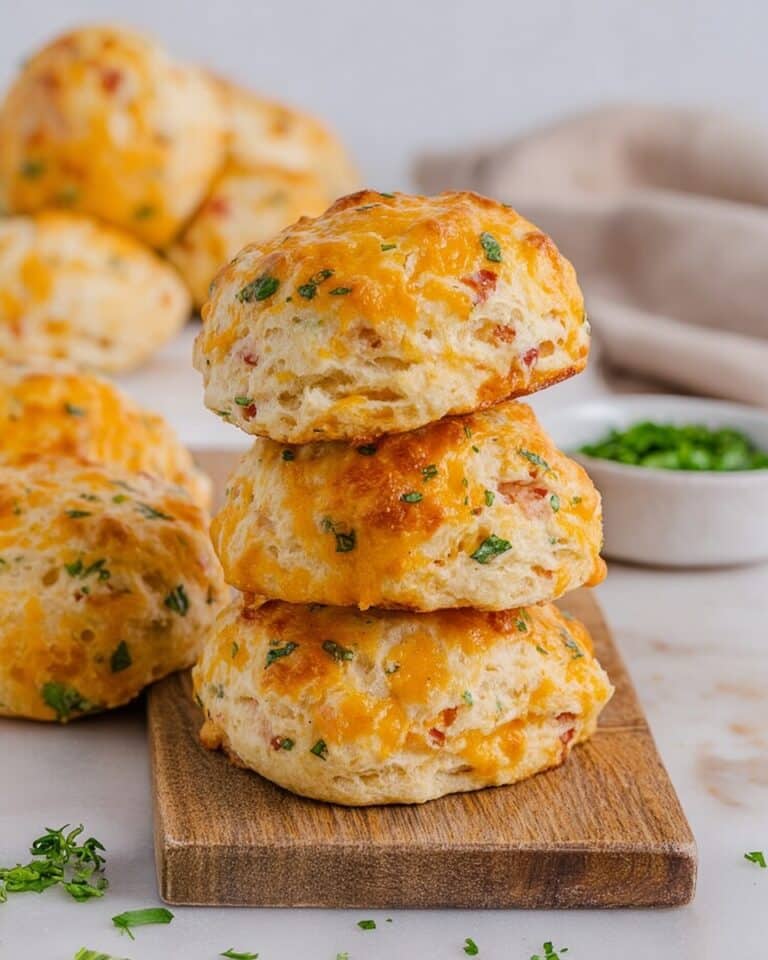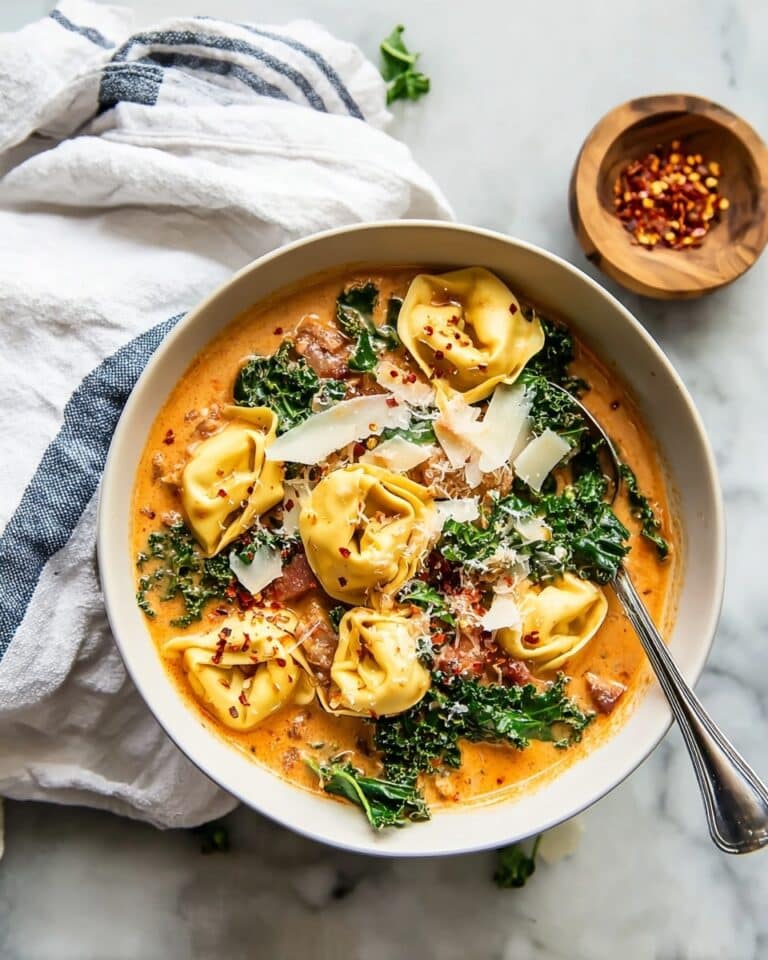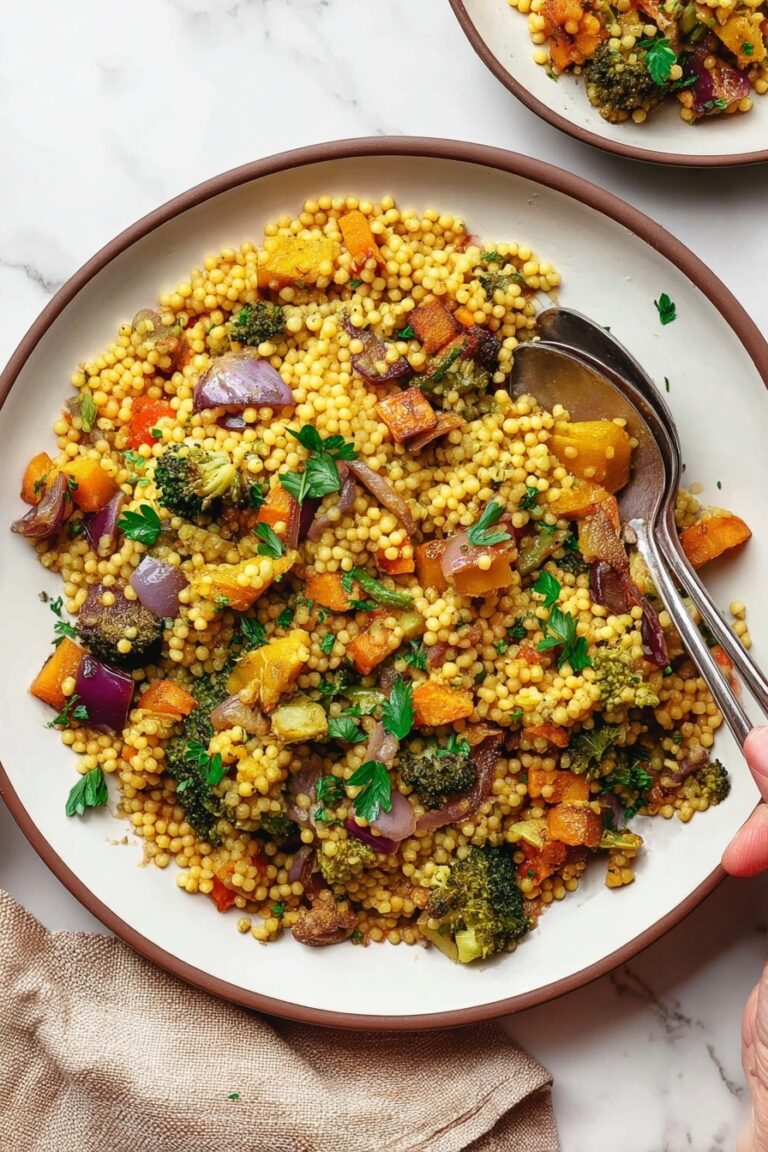Kung Pao Chicken Recipe
If you’re craving a dish that’s bursting with flavor, all while being quick enough for a weeknight dinner, you’ve got to try this Kung Pao Chicken Recipe. I first made it on a whim, and instantly fell in love with the perfect balance of spicy, sweet, and savory notes that dance on your tongue—plus that satisfying crunch from the peanuts. Trust me, once you try this recipe, it’ll quickly become one of your go-to meals!
Why This Recipe Works
- Balanced Flavor Profile: The recipe hits every note—spicy, sweet, tangy, and savory all at once for a memorable meal.
- Easy Weeknight Cooking: With a quick marinade and fast cooking, you’re ready to eat in about half an hour.
- Versatile Ingredients: You can swap chicken cuts or veggies based on what you have at home, making it super adaptable.
- Authentic & Homemade: Uses classic elements like Shaoxing wine and chili crisp for true Kung Pao flavor without eating out.
Ingredients & Why They Work
This Kung Pao Chicken Recipe brings together ingredients that each play their part beautifully to create deep flavor and vibrant textures. You’ll find tips here on choosing the best options to make this dish shine.
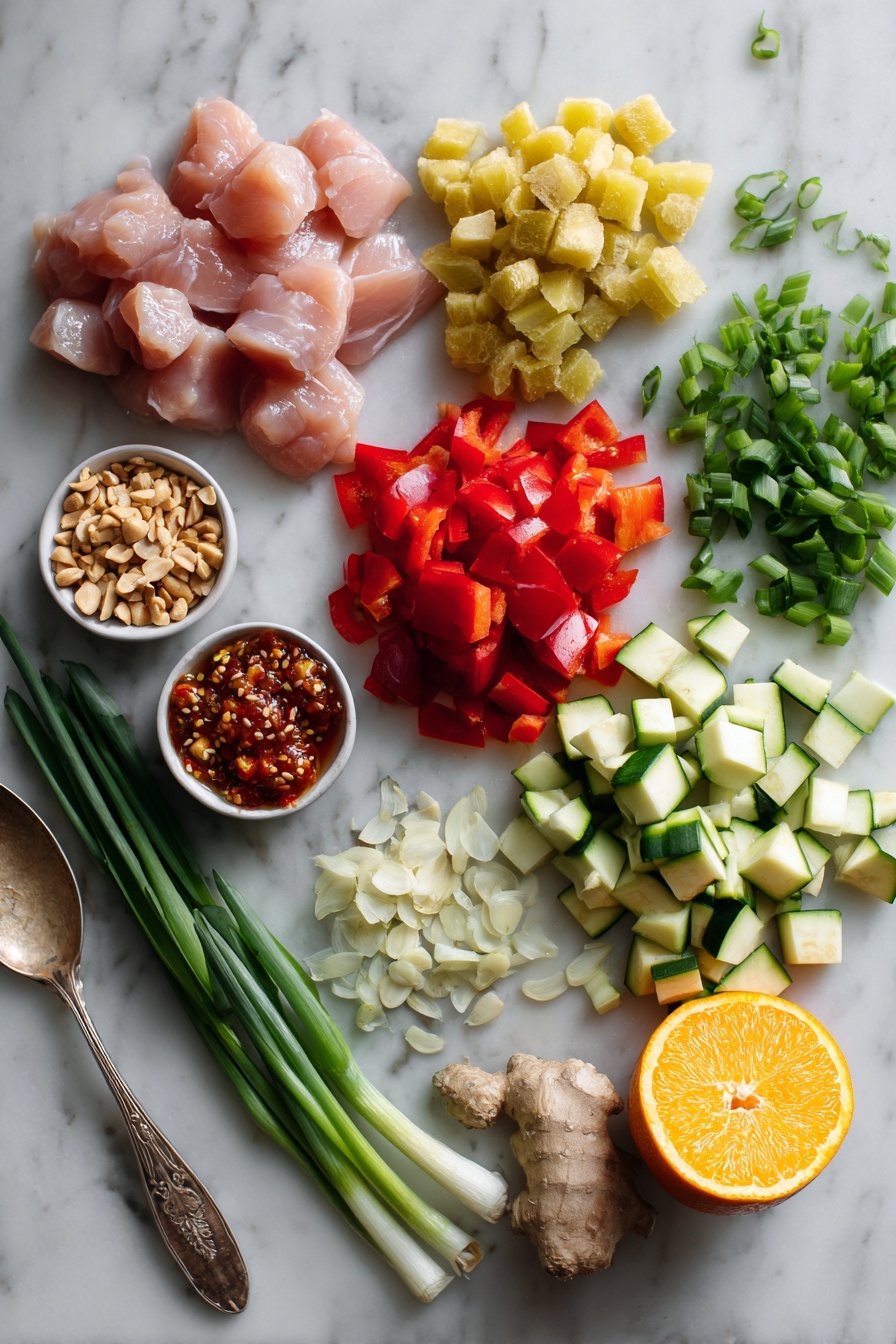
- Chicken breasts or thighs: Thighs give more juiciness and flavor, but breasts keep it lean and cook faster.
- Low sodium soy sauce: Controls saltiness while delivering umami richness.
- Cornstarch: The secret for velvety chicken and thickened sauce without heaviness.
- Sherry or Shaoxing wine: Adds that distinctive depth and aroma—the real deal in Chinese cooking!
- Vegetable oil: For a clean high-heat sear, giving the chicken a beautiful crust.
- Red and green bell peppers: Provide sweetness and a fresh crunch with vibrant color.
- Zucchini: Adds a subtle, juicy texture that soaks up sauce perfectly.
- Onion, garlic, and ginger: The classic aromatic trio that layers tons of flavor.
- Balsamic vinegar & honey: Create that irresistible tangy-sweet balance in the sauce.
- Hoisin sauce: Gives a deep, slightly smoky sweetness that rounds out the flavors.
- Chili crisp: The spicy, crunchy star—feel free to adjust based on your heat preference!
- Chicken broth: Enhances umami richness in the sauce without overwhelming it.
- Orange zest & juice: A fresh zing that makes this Kung Pao Chicken Recipe stand out with a lovely citrus brightness.
- Roasted salted peanuts or cashews: For the essential crunch and saltiness at the finish.
- Green onions and sesame seeds: Garnishes that add freshness and subtle nuttiness.
Tweak to Your Taste
One of the things I love most about my Kung Pao Chicken Recipe is how flexible it is—so don’t hesitate to make it your own! I often adjust the spice level and swap veggies depending on what’s fresh or what my kids will eat that night.
- Mild Version: I keep the chili crisp to a minimum and serve extra on the side, so everyone can add their preferred heat.
- Veggie Swap: Broccoli or snap peas are awesome alternatives to zucchini and peppers—and they soak up the sauce beautifully.
- Protein Options: Tried it with tofu? Yes! Press it well, marinate, and pan-fry for a vegetarian spin that’s just as tasty.
- Extra Crunch: Feel free to toss in some water chestnuts or bamboo shoots for authentic texture and that little surprise bite.
Step-by-Step: How I Make Kung Pao Chicken Recipe
Step 1: Marinate to Infuse Flavor
I always start by whisking together the marinade—a combo of low sodium soy sauce, cornstarch, and that magic touch of Shaoxing wine. Cutting the chicken into uniform one-inch pieces helps everything cook evenly. I let the chicken soak in that marinade at room temperature for about 15 minutes—this little wait is crucial for tender, flavorful chicken. Don’t skip it!
Step 2: Prepare Your Veggies and Aromatics
While the chicken marinates, take time to chop your bell peppers into bite-size squares and slice zucchini into little chunks. Mince your garlic and grate fresh ginger separately because they’ll hit the pan a bit later for punchy flavor. I like to keep the veggies crisp-tender, so timing here matters.
Step 3: Mix the Zesty, Spicy Sauce
In a small bowl, whisk together the sauce ingredients—cornstarch, balsamic vinegar, honey, soy sauce, hoisin, chili crisp, chicken broth, orange zest, and fresh juice. This vibrant sauce ties the whole dish together. I leave the whisk in the bowl to ensure it stays mixed until it hits the pan.
Step 4: Sear the Chicken to Golden Perfection
Using a well-heated 12-inch cast iron skillet or wok is key here. Add a tablespoon of vegetable oil, and when it’s shimmering, add the chicken pieces spaced apart. Don’t rush to stir—let that sear develop for 2-3 minutes until golden and crispy on one side; then flip and brown the other side. If your pieces are large, lower the heat after searing to finish cooking through without burning. Once cooked, set the chicken aside—you’ll thank me later.
Step 5: Sauté the Veggies and Aromatics
In the same pan, add a bit more oil and crank the heat back up for your peppers, zucchini, and onions. Stir-fry them just until they’re crisp-tender—about two minutes should do. Then toss in the garlic and ginger, stirring for another minute or two. This keeps those flavors bright and fresh without getting mushy.
Step 6: Bring It All Together
Now for the magic moment—return the chicken and any juices to the skillet with your veggies. Pour in all that orange chili sauce, scraping up the tasty browned bits from the chicken’s sear. Stir in half a cup of roasted peanuts or cashews, coating everything in the luscious sauce. Then, remove from heat before the sauce thickens too much; it will continue to thicken as it cools.
Step 7: Garnish and Serve
Finish with a handful of chopped green onions and a sprinkle of toasted sesame seeds for added color and texture. I always pass around extra chili crisp at the table—once people try it, they want more heat! Serve this masterpiece hot over your favorite rice—I’m partial to Coconut Jasmine Rice for that extra little indulgence.
Pro Tips for Making Kung Pao Chicken Recipe
- Use Shaoxing Wine if You Can: It imparts an authentic aroma that’s subtle but unmistakable—no good substitute in my opinion!
- Don’t Crowd the Pan: Sear the chicken in batches—crowding will steam it instead of browning, and you’ll lose that wonderful texture.
- Prep Everything Before Starting: This recipe moves quickly once the pan is hot, so have all your chopped veggies and sauce ready to go.
- Adjust Heat at Serving: Chili crisp varies in spice, so add it gradually and keep extra on the side for guests to customize.
How to Serve Kung Pao Chicken Recipe

Garnishes
I always top my Kung Pao Chicken with chopped green onions and a sprinkle of white sesame seeds—it adds that fresh pop of color and subtle nuttiness that makes the dish feel special. Sometimes, if I have fresh cilantro on hand, a little sprig makes a lovely vibrant finish.
Side Dishes
This dish’s bold flavors pair fantastically with simple steamed rice—my favorite is Coconut Jasmine Rice, which adds a creamy, sweet contrast. For a lighter option, cauliflower rice works great and soaks up the sauce nicely. To keep the meal balanced, I sometimes add a side of steamed broccoli or sautéed bok choy.
Creative Ways to Present
Once, I made this Kung Pao Chicken Recipe for a casual dinner party and served it family-style in a large, colorful wok right at the center of the table. It created a lively atmosphere, and guests loved piling rice on their plates with generous helpings. For a fancier twist, spoon it over jasmine rice in individual bowls and garnish with extra peanuts and chili crisp for visual appeal.
Make Ahead and Storage
Storing Leftovers
I keep leftovers in an airtight container in the fridge where they stay fresh for about 3 days. The chicken and veggies hold up surprisingly well, especially if you slightly undercook the veggies during the initial stir-fry so they don’t get mushy when reheated.
Freezing
While I usually prefer eating this fresh, you can freeze the cooked Kung Pao Chicken—it freezes best without the peanuts added, so stir those in after reheating. Freeze in a well-sealed container for up to 2 months. Thaw overnight in the fridge before reheating.
Reheating
I reheat leftovers gently in a skillet over medium heat with a splash of water or chicken broth to keep things moist. This helps revive the sauce without drying out the chicken or veggies. Microwave works in a pinch, but the skillet method keeps flavors and textures best.
FAQs
-
Can I use chicken thighs instead of breasts for this Kung Pao Chicken Recipe?
Absolutely! Chicken thighs add more juiciness and flavor due to their higher fat content, which many people love for this dish. Just cut them into the same size as breasts so they cook evenly. I often use thighs myself for their tender texture.
-
What’s the best way to control the heat in this recipe?
The amount of chili crisp you use is the easiest way to dial the heat up or down. Start with less in the sauce, then offer extra on the side so diners can customize. You can also omit or reduce chili crisp and add diced fresh chilies or red pepper flakes if you prefer different heat profiles.
-
Can I make this Kung Pao Chicken Recipe gluten-free?
Yes! Just swap your soy sauce for tamari or coconut aminos to keep it gluten-free without sacrificing flavor. Double-check your hoisin sauce and chili crisp as some brands contain gluten—there are gluten-free versions available or you can omit and add extra sweetness and spice with substitutes.
-
Is Shaoxing wine necessary for the marinade?
While Shaoxing wine adds authentic depth, you can substitute dry sherry or even a splash of dry white wine if you can’t find it. Just avoid sweet cooking wines, which alter the flavor balance. If you skip it altogether, the dish will still be tasty but less complex.
Final Thoughts
This Kung Pao Chicken Recipe has a special place in my weekly dinner rotation because it’s just so reliable—full of flavor, quick, and crowd-pleasing. Every time I make it, I get comments about how restaurant-quality it tastes, but without the hassle. Give it a try for your next meal, experiment with little tweaks, and I bet it will become one of your favorite homemade Chinese dishes too!
Print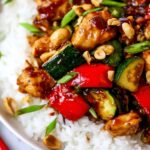
Kung Pao Chicken Recipe
- Prep Time: 30 minutes
- Cook Time: 6 minutes
- Total Time: 36 minutes
- Yield: 6 servings
- Category: Main Course
- Method: Stovetop
- Cuisine: Chinese
Description
This flavorful Kung Pao Chicken recipe features tender marinated chicken pieces seared to perfection, crisp-tender vegetables, and a vibrant orange-chili sauce with a hint of sweetness. Garnished with roasted peanuts, green onions, and sesame seeds, it’s a delightful and spicy dish perfect served over hot rice.
Ingredients
For the Marinade:
- 1/4 cup low sodium soy sauce
- 1 tablespoon cornstarch
- 1 tablespoon sherry or Shaoxing wine
- 1 and 1/2 pounds chicken breasts or chicken thighs, cut into 1-2 inch pieces
- 1 tablespoon vegetable oil, plus more for searing
For the Veggies:
- 1 tablespoon vegetable oil, for sautéing the veggies
- 1 red bell pepper, chopped into squares
- 1 green bell pepper, chopped into squares
- 2 small zucchini, sliced into 2 inch pieces
- 1/2 cup onion, chopped
- 4 cloves garlic, smashed and minced
- 1 and 1/2 inches fresh ginger, grated or minced (about 1 tablespoon) or 1 tablespoon ginger paste
For the Sauce:
- 2 teaspoons cornstarch
- 2 tablespoons balsamic vinegar
- 2 tablespoons honey
- 2 tablespoons low sodium soy sauce
- 1 tablespoon hoisin sauce
- 1 tablespoon chili crisp (adjust to taste)
- 1/2 cup chicken broth (or substitute with 1/2 cup water and 3/4 teaspoon Better Than Bouillon Chicken base)
- 1 teaspoon orange zest, from 1 orange
- 3 tablespoons fresh orange juice, from 1/2 an orange
To Serve:
- 1/2 cup roasted salted peanuts or roasted salted cashews
- Chopped green onions for garnish
- White sesame seeds for garnish
- Hot rice (such as Coconut Jasmine Rice, white rice, brown rice, cauliflower rice, or basmati rice)
Instructions
- Marinate the chicken: In a medium bowl, whisk together 1/4 cup low sodium soy sauce, 1 tablespoon cornstarch, and 1 tablespoon sherry or Shaoxing wine. Cut the chicken into 1-2 inch pieces and add to the marinade. Stir to coat well and set aside at room temperature for 15 minutes.
- Prepare the vegetables: Chop the red and green bell peppers into squares. Slice the zucchini lengthwise and chop into 2 inch pieces. Chop 1/2 cup onion. Smash and mince 4 cloves of garlic. Peel and mince or grate 1 and 1/2 inches fresh ginger. Set garlic and ginger aside separately from other vegetables.
- Make the sauce: In a small bowl, whisk together 2 teaspoons cornstarch, 2 tablespoons balsamic vinegar, 2 tablespoons honey, 2 tablespoons low sodium soy sauce, 1 tablespoon hoisin sauce, 1 tablespoon chili crisp, 1/2 cup chicken broth, 1 teaspoon orange zest, and 3 tablespoons fresh orange juice. Keep the whisk in the bowl for a final stir before adding to the skillet.
- Sear the chicken: Heat a 12-inch cast iron skillet or wok over medium-high heat for 2-3 minutes until very hot. Add 1 tablespoon vegetable oil and swirl to coat the pan. Add chicken pieces in batches with space between each piece. Let cook undisturbed for 2-3 minutes until browned on the bottom. Flip and sear the other side for about 1 minute. Reduce heat to medium and cook a few more minutes until chicken reaches an internal temperature of 160°F or no longer pink inside. Remove chicken to a plate and repeat with remaining pieces.
- Cook the vegetables: Add 2 tablespoons vegetable oil to the same skillet and increase heat to medium-high. Add the bell peppers, onion, and zucchini. Sauté for about 2 minutes until crisp-tender. Add garlic and ginger; stir and cook another 1-3 minutes to desired tenderness, keeping vegetables crisp-tender.
- Combine chicken and sauce: Return the cooked chicken and any juices to the skillet with the vegetables. Pour in the prepared orange chili sauce and stir to combine, scraping up browned bits from the pan. Stir in 1/2 cup roasted peanuts or cashews to coat with sauce. Remove from heat.
- Garnish and serve: Sprinkle with chopped green onions and white sesame seeds. Serve hot over rice such as Coconut Jasmine Rice, white rice, brown rice, cauliflower rice, or basmati rice. Offer extra chili crisp sauce at the table for added spice.
Notes
- For the chicken broth substitute, mix 1/2 cup water with 3/4 teaspoon Better Than Bouillon Chicken base.
- If you don’t have a cast iron skillet, use your heaviest skillet or a wok for best results.
- Adjust the amount of chili crisp to control spiciness according to preference.
- Vegetables should remain crisp-tender to reflect traditional Kung Pao texture and flavor.
- Serving with coconut jasmine rice adds a lovely aromatic complement to the bold flavors in this dish.
Nutrition
- Serving Size: 1 serving
- Calories: 320 kcal
- Sugar: 12 g
- Sodium: 650 mg
- Fat: 15 g
- Saturated Fat: 2.5 g
- Unsaturated Fat: 10 g
- Trans Fat: 0 g
- Carbohydrates: 18 g
- Fiber: 3 g
- Protein: 28 g
- Cholesterol: 70 mg

